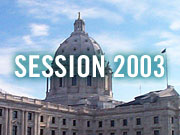Audio
Photos
More from MPR
Your Voice
| ||||||||||||||||||||||||||||||||||||||||||||||||||||
Educators weigh impact of school funding bill
May 30, 2003
 |
| Teachers, parents and children sing songs in an Early Childhood and Family Education class in Apple Valley. (MPR Photo/Tim Pugmire) |
St. Paul, Minn. — Gov. Pawlenty promised to try to protect K-12 education from the budget ax. The basic funding amount for each student will hold steady at $4,601. But that won't prevent school districts from cutting programs, increasing class sizes or laying off employees.
Scott Croonquist, executive director of the Association of Metropolitan School Districts, says an inflationary increase is essential each year. He says the tax law reforms passed in 2001, obligate the state to cover that cost.
 | |||
"Well, I think that means you have to find a way to fund education even if there's a budget shortfall, even when the economy goes down," Croonquist said. "And so, clearly that didn't happen this year. The basic formula is frozen. And anytime you freeze the basic formula allowance, that's going to take a toll on educational programs."
Croonquist says K-12 education did fare better than other parts of the state budget. But he says cuts in programs outside of the regular classroom will cause real pain. Overall school spending is reduced about two percent. Programs for English language learners, summer school, special education and community education are among those hardest hit.
At the Early Childhood Learning Center in Apple Valley, teachers, parents and children begin an activity known as circle time. This weekly class for two-year-olds and their parents is part of the Early Childhood and Family Education program, or ECFE. Families pay a fee for the 15-week course based on their income level. Under the education funding bill, ECFE programs statewide will see a 20 percent cut next year.
Karen Kellar, ECFE manager for the Rosemount-Apple Valley-Eagan school district, says fees are already scheduled to increase this fall. She says the cut in state funding will be a big challenge.
 | |||
"And we are going to have a lot of people that will be turned away," Kellar said. "Our other option is if we don't raise fees we're talking about cutting back programming. And then we have to make decisions about who gets to take classes and who doesn't." Judy Otteson, who attends the Apple Valley ECFE with her daughter Emily, says the classes help develop her parenting skills and Emily's social development. "If the participation fees increase we probably won't be able to participate," Otteson said. "My husband was recently laid off. We're a one-income family, and his income is half of what it used to be. So, I don't know if we'll be able to, depending on how much they increase, I don't know if we'll be able to participate any longer."
Participation is also expected to drop in summer school and after-school programs. The funding bill reduces the money directed to learning opportunities outside of the regular school day. Lawmakers provided more money toward the state share of local tax levys.
Brad Lundell, executive director of Schools for Equity in Education, says the increase will benefit rural and suburban school districts with low property values.
"We think that low property wealth districts are on a much more even playing field when it comes to raising their taxes," Lundell said. "Is that going to solve all the problems? No. But is it going to really help low property wealth districts face these challenges? I think that's a clear yes."
One of the big challenges facing all school districts is negotiating new employee contracts with no new money. Legislators did not freeze public employee salaries or tinker with labor laws. They did, however, waive the January 15 deadline for settling with teachers.
"We're concerned that particularly in this very difficult time of funding that we could see even more districts that don't reach agreements, and this bargaining drags on well into the school year," says Judy Schaubach, president of the teacher's union Education Minnesota. "And we think frankly that isn't good for anybody."
Schaubach says teachers will be realistic about their contract expectations.
|
News Headlines
|
Related Subjects
|

